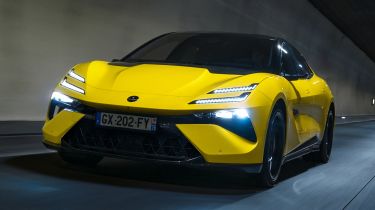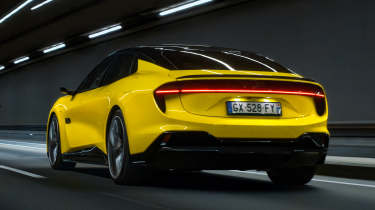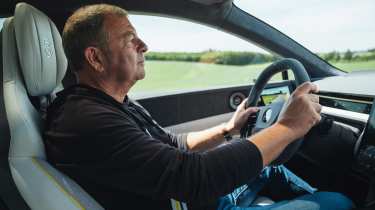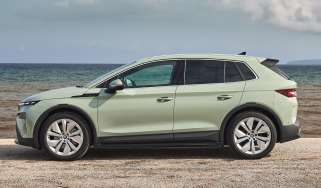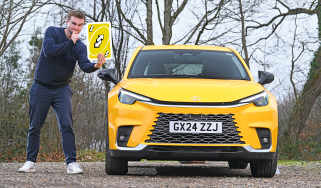New Lotus Emeya 2024 review: has the Porsche Taycan met its match?
The new Lotus Emeya is a great electric car that’s packed with quality and tech

Verdict
Forget any preconceptions you might have about it because, in reality, the Lotus Emeya is a seriously good electric sports GT. On the road it’s a match for any Porsche Taycan, and in the showroom it’s right up there on quality, tech and usability, as well. This is a great new car from Lotus, simple as that.
If the Eletre SUV was the warm-up act for the brave new EV-only world that Lotus is heading towards, the more sporting and much more focused Emeya is very much the headline performance.
Based unashamedly on the underpinnings of its SUV sibling, but adding an extra dose of style, a far sleeker looking five-door coupe bodyshell and a sharper range of dynamics, the Lotus Emeya is a credible rival for the Porsche Taycan.
In S guise it costs £101,950 and comes with 604bhp and 710Nm courtesy of a 112kWh battery that powers a pair of 225kW electric motors. That means it’s priced to compete with a Taycan 4S but offers performance not that far shy of a Turbo. And if you want the full hyperspace experience from your Emeya, there’s always the R version (£129,950), which has 905bhp and 985Nm, can hit 62mph in just 2.8 seconds, and live with almost any car you’d care to line it up against in a straight line.
More reviews
The tech contained within the Emeya is right at the cutting edge when it comes to production electric cars, with an 800-volt architecture capable of charging the car from 10-80 per cent at a 350kW DC charge point in just 18 minutes, says Lotus. An 22kW AC charger takes 5.5 hours to fill to 100 per cent, providing a combined WLTP range of 379 miles – a figure that extends to a claimed 408 miles during city driving.
Its navigation system has also been designed so that the car knows precisely where the most appropriate charging points are along your route, enabling you to reach your destination most efficiently. The system pre-conditions the battery to be able to accept the correct amount of charge from whatever charge point you are heading towards, which further reduces potential wait times and makes driving the Emeya easier and simpler, especially on longer trans-continental journeys. Range anxiety – at least in central Europe where the charge network is at its best – simply doesn’t exist.
Inside and out there are some great design touches, many of which help elevate the Emeya to an extremely high level for perceived build quality. It looks and feels like a genuine luxury product inside with great seats, high-class fabrics, a high-end Kef stereo, a brilliant new central touchscreen, and enough analogue switches to keep most traditionalists happy. The touchscreen measures 15.1 inches and features an OLED display that is more intuitive to use than most. The optional camera mirrors, on the other hand, are not so slick; we never quite acclimatised to them, though they do apparently shave 118mm from the overall width compared with the standard set-up.
There are five different drive modes to choose from; Range, Tour, Sport, Individual and Track. These are accessed via the right hand paddle shifter and alter the way the throttle, steering and dampers feel on the move. The left hand paddle increases or decreases the strength of the regenerative braking system.
It all feels a bit strange to begin with, swapping between drive and braking modes on what you initially think are gear shift paddles. But like much of the tech contained within the Emeya, you quickly get used to it and learn to use the paddles to change modes more than you otherwise would.
We drove both versions extensively over two days in Germany and Austria, and although the R model impressed to begin with, what with its endless acceleration and its trick ‘active’ anti-roll suspension, we thought the S was the sweeter of the two overall – and not just because it costs £28k less.
No, we preferred the S because its ride and handling felt even more natural – even more Lotus, if you will – beside the sharper but more aggressive-feeling R. The S isn’t as bombastic as the flagship when you deploy full power, lacking the more expensive version’s ‘where’s-my-face-gone’ factor in a straight line. But in most other respects it felt more fluid and better balanced than the R, with more analogue responses to its steering and brakes (steel not carbon unlike the R’s) and a calmer sense of balance to its power delivery. Of the two it’s the one that takes the battle most convincingly to a Porsche Taycan for pure driver appeal.
In any case, the S is still very, very quick, even if it lacks the outright party tricks the R can perform at any speed this side of 150mph. Until its range runs out, that is, which happens much faster than it does in the S because the temptation to use (and abuse) its energy is that much harder to resist. Its WLTP range is a not insignificant 109 miles shorter than the S.
Elsewhere, space inside the Emeya is excellent, with acres of legroom in the back (the car is 5.13m long, remember) and a lot more headroom than you’d expect given how much lower the roofline is. This is partly because the Emeya’s battery pack is flatter than the Eletre’s, but it’s also the result of some clever interior packaging that has created an abundance of space in all dimensions. This includes a boot that extends from 426 litres in optional four-seat configuration to 509 litres in standard, five-seat guise. You can even fold them flat to reveal an impressive 1,388-litre load bay.
| Model: | Lotus Emeya S |
| Price: | £101,950 |
| Powertrain: | 112kWh battery, 2x e-motors |
| Power/torque: | 604bhp/710Nm |
| Transmission: | Single-speed auto, four-wheel drive |
| 0-62mph: | 4.3 seconds |
| Top speed: | 155mph (limited) |
| Range: | 379 miles |
| Charge times: | 350kW, 10-80% in 18min |
| On sale: | Now |

